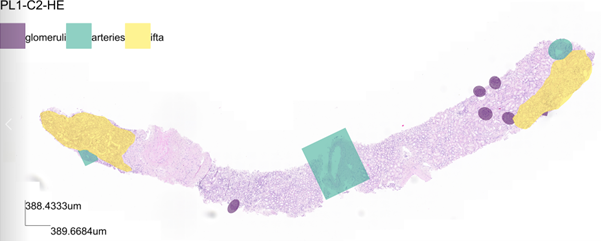1 minute read
In a recent article NPL’s Digital Pathology Team provided an insight into their work. Here the team share specific examples of the impact of their work:
Improving the reliability of image-based assessment of kidney health for organ transplant
Kidney health can be diagnosed by inspecting a piece of kidney tissue (a biopsy) under a microscope. A UK-wide national trial is underway to establish how well kidney biopsy images can predict kidney health. We are working with trial clinicians to study the variabilities that affect diagnosis and the ways in which we can reduce them. As part of this we are preparing a clinical paper to inform transplant surgeons about the impact of kidney tissue processing on the reliability of diagnosis.
A well-known computational challenge in both Molecular and Digital Pathology imaging is the sheer volume of the data. A single image ranges up to 5 GB in size, exceeding 43 billion pixels. Another challenge is the granularity of labelling and extraction of features in the data (Fig. 1). To solve these challenges, we are working on the methods to efficiently process these large images. Preliminary results have been presented at Mathmet annual congress 2022 and are being prepared for an invited publication in Metrologia in 2023. The Mathmet presentation is available on https://www.lne.fr/system/files/pdf/MATHMET-2022-Presentations-Wednesday-2-November.zip.

Figure 1 Piece of stained kidney tissue with diagnostically relevant regions marked by colour patches.
Using calibration objects to study whole slide imaging device variability
Variations between Whole Slide Imaging devices (WSIs) have been known to impact on-display and in-silico image analysis and diagnosis. To quantify these variations, we are using two commercially available calibration objects and imaging them on several commonly available WSI devices. Having completed the data collection in 2022, we will focus our efforts in 2023 on the analysis of variations image properties and methods to improve the comparability of data sets acquired on different WSI devices.
Find out more about NPL’s work with Data Science
15 Mar 2023